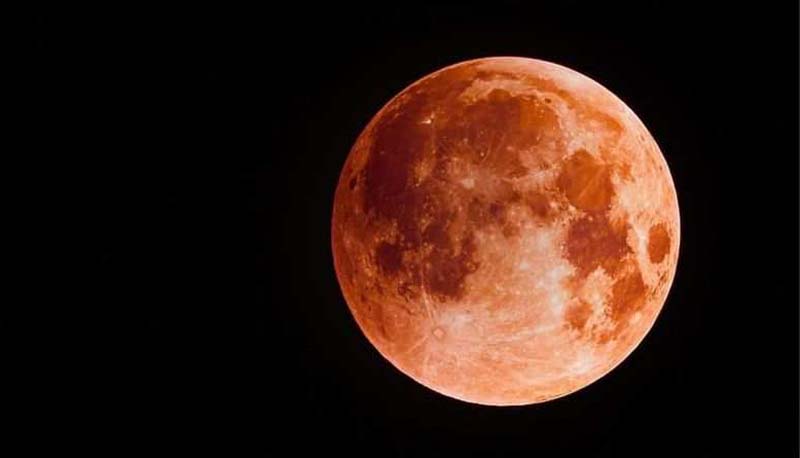HYDERABAD, Nov 5: The last Eclipse of year 2022 and first Lunar Eclipse to be visible this year in India will occur on November 8.
This eclipse is a Total Lunar Eclipse, however it will be visible partially in most of the country whereas at few places people would witness the totality in the end of Totality phase, Planetary Society of India (PSI) Director N Sri Raghunandan Kumar said in a release on Saturday.
He said across the world, this eclipse will be visible in the region covering South America, North America, Australia, Asia, the North Atlantic Ocean, and the Pacific Ocean.
There are Four Eclipses in the year 2022 in which only two (October 25–solar eclipse) & November 8) are visible in India.
The Last Lunar Eclipse visible in India occurred on November 19, 2021 which was Longest Partial Lunar Eclipse in 580 Years.
As recorded by NASA from New Orleans, the duration of Partial Eclipse on November 19, 2021 was for 3 hours 28 Minutes and 24 Seconds. Whereas the Next Eclipse visible from India which is Partial Lunar Eclipse will occur on the night of October 28 and 29 in 2023, the PSI Director said.
Mr Kumar said Eclipse in various phases begins at 1.30 p.m and ends at 7.28 pm.
However, the noticeable Umbral phase begins at 2.39 p.m. and ends at 6.19 p.m.
In other words, though astronomically speaking, the Eclipse begins at 1.30 p.m with moon entering lighter Shadow of Earth.
People can noticeably witness darkening or leaving of Moon’s disk by Earth Shadow between 2.39 p.m to 6.19 p.m. on next Tuesday. Whereas the Totality Phase when Moon’s disk is completely immersed in Dark shadow of Earth starts at 3.46 p.m. and ends at 5.12 p.m.
He said in India, Agartala, Aizawl, Bhagalpur, Bhubaneswar, Cooch Behar, Cuttack, Darjeeling, Dibrugarh, Gangtok, Guwahati, Gaya, Hazaribagh, Imphal, Itanagar, Kohima, Kolkata, Midnapore, Murshidabad, Muzaffarpur, Patna, Port Blair, Puri, Ranchi, Shillong, Sibsagar, Silchar, Siliguri, Tamelong, Varanasi, Chittagong are the places where the people can witness the Moon full eclipsed in Earth’s dark shadow towards end of the Totality phase at 5.12 p.m.
Whereas rest of the country people can witness the eclipse in partial phase only with a portion of Moon Disk eclipsed.
The PSI Director also said people in Eastern or North Eastern most parts of India like Dibrugarh will be the first to see the eclipse starting 4.17 p.m. In India. They will see the Moon completely immersed in dark shadow of earth as the Totality phase already started at 3.46 p.m. Whereas people in Itanagar & Kohima will see the eclipse starting from 4.24 p.m. People in Northern most parts of India like Ladakh will see eclipse from 5.17 p.m.
People in Central part of India like in Bhopal would start seeing the eclipse from 5.36 p.m.
Whereas people in Southern most part of India that is Kanyakumari will witness the eclipse from 5.57 p.m. In Kavaratti (Lakshadweep), eclipse is visible from 6.11 p.m. People in Western most parts of India like in Dwaraka will be last to witness the eclipse from 6.12 p.m. for just 7 minutes before end of Umbral Phase at 6.19 p.m. Here people will see a very small part of Moon Disk eclipsed. This means duration of the eclipse and percentage of Moon disk eclipsed would differ as we move from East or North parts towards Western and Southern part of India depending on rising time of moon for a location, he explained.
Mr Kumar said People in Hyderabad can see the eclipse from 5.40 p.m. in Telangana. Whereas People in Vijayawada in Andhra Pradesh will start seeing eclipse at 5.33 p.m. Whereas people in Rajahmundry will see eclipse from 5.25 p.m. It’s important to note people in north and north eastern part of both states would be first to witness the eclipse compared to Western or Southern parts.
Duration and Percentage of Lunar Eclipse visible be based Rising time of Moon in their location, he said as Totality phase is already over at 5.12 p.m. before moon rises in Telugu States, People here would miss totality and would see only a portion of Moon’s disk eclipsed under the dark shadow of earth.
A Lunar Eclipse occurs when earth in course of its orbit around sun, comes between moon and sun such a way that moon is hidden in the shadow cast by earth. This can occur only when the Sun, Earth, and Moon are aligned in a straight line. Hence lunar eclipse occurs only when there is full moon, he said. (UNI)
Trending Now
E-Paper


